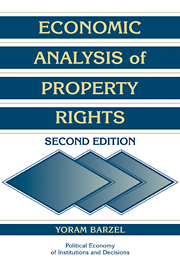Book contents
- Frontmatter
- Contents
- Series editors' preface
- Preface to the second edition
- Preface to the first edition
- Introduction
- 1 The property rights model
- 2 The public domain: Rationing by waiting and price controls
- 3 Contract choice: The tenancy contract
- 4 Divided ownership
- 5 The old firm and the new organization
- 6 The formation of rights
- 7 Slavery
- 8 Wealth-maximizing constraints on property rights
- 9 Property rights and non-market allocation
- 10 Additional property rights applications
- 11 The property rights model: Recapitulation
- References
- Index
10 - Additional property rights applications
Published online by Cambridge University Press: 05 June 2012
- Frontmatter
- Contents
- Series editors' preface
- Preface to the second edition
- Preface to the first edition
- Introduction
- 1 The property rights model
- 2 The public domain: Rationing by waiting and price controls
- 3 Contract choice: The tenancy contract
- 4 Divided ownership
- 5 The old firm and the new organization
- 6 The formation of rights
- 7 Slavery
- 8 Wealth-maximizing constraints on property rights
- 9 Property rights and non-market allocation
- 10 Additional property rights applications
- 11 The property rights model: Recapitulation
- References
- Index
Summary
In previous chapters I demonstrated the expediency of using the property rights approach to explain various aspects of such specific phenomena as gasoline price controls and slavery, and to develop a general approach to, among other things, non-market allocation, the maximizing role of restrictions on private property rights, and, in the context of farm tenancy, the choice among various forms of control. The property rights framework can be applied to other problems as well. I shall now briefly consider several of these problems, beginning with an analysis of the individuals' ability to protect themselves against losses to monopoly, proceeding to a discussion of the relationship between property rights and theft and of property rights in relation to innovation and to price information, and concluding with an exploration of property rights as they relate to wildlife.
PROTECTION AGAINST LOSSES TO MONOPOLY
Monopolies are said to result in resource misallocation, which takes two forms. The first and better-known type of misallocation arises because monopolies produce “too little,” charging prices that exceed marginal costs, whereas the second type arises in the process of creating monopolies. Would-be monopolists spend resources in order to attain monopoly positions, and such expenditures are dissipating. The magnitude of these capture costs is comparable to that of the expected profits of the monopoly. Naturally, monopolists have economic rights to whatever gains they obtain. Since monopolists' gains exceed their contributions, their gains occur, in part, at the expense of others; thus, they also seem to have the right to harm other people.
- Type
- Chapter
- Information
- Economic Analysis of Property Rights , pp. 139 - 147Publisher: Cambridge University PressPrint publication year: 1997
- 1
- Cited by



